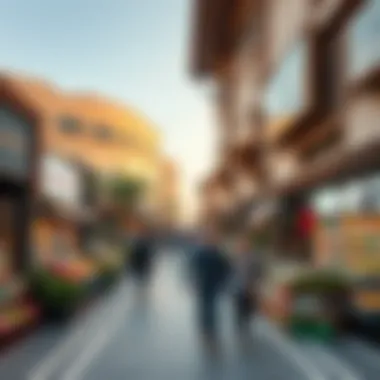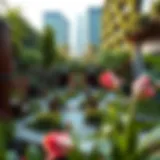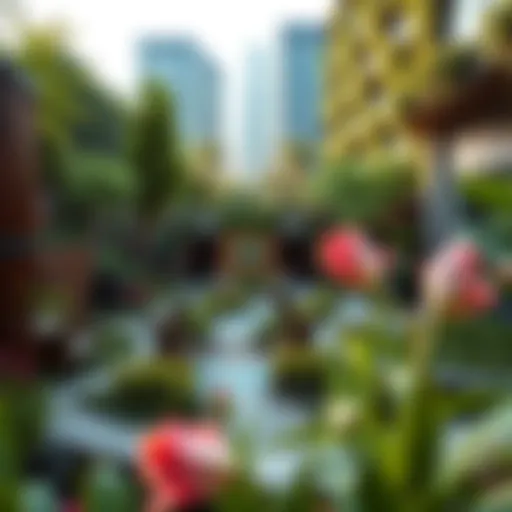Meena Bazaar's Impact on Dubai's Real Estate Market


Market Trends
Current Market Analysis
Meena Bazaar, often regarded as one of the cornerstones of Dubai’s bustling marketplace, has witnessed a significant transformation over the years. This market not only caters to the local population but also attracts tourists and international investors alike. The confluence of various cultures within this vibrant district has induced a unique essence into the shopping and economic landscape of Dubai.
Recent data indicates an upward trend in property values surrounding the Meena Bazaar area. According to the Dubai Land Department, properties near this hub have recorded an increase of approximately 15% in rental yields over the past three years. This is largely attributed to the area’s strategic location and the influx of expatriates searching for both residential and commercial opportunities.
Local businesses thrive on the diverse clientele drawn to Meena Bazaar's rich culture and assortment of goods. From traditional garments to culinary delicacies, the bazaar serves as a microcosm of Dubai’s melting pot. Hence, real estate in proximity to such thriving commerce becomes an attractive prospect for investors and homebuyers. Notably, the surrounding neighborhoods of Karama and Bur Dubai have shown promising growth, as they experience a trickle-down effect from Meena Bazaar's economic vitality.
Future Projections
Looking ahead, the trajectory of the real estate market in this area looks promising. With the impending Expo 2025 set to boost tourism and infrastructure development, analysts predict a heightened demand for properties. This will likely yield increased interest from investors eyeing both short-term rental properties as well as long-term residential options.
Investors can also expect a spike in mixed-use developments in the upcoming years. This shift might not only provide more residential options but also ensure that commercial spaces remain strategically located to benefit from the foot traffic generated by Meena Bazaar. Furthermore, as Dubai continues to improve its transportation links and public facilities, property values are poised to rise further.
Key factors to monitor in the near future include:
- The impact of ongoing infrastructure projects on property value.
- Changes in zoning laws that might affect property types.
- Economic indicators related to tourism and local commerce growth.
"Understanding the market trends around Meena Bazaar is crucial for any investor looking to make a move in Dubai's dynamic real estate landscape."
Property Insights
Neighborhood Comparisons
Diving deeper into the neighborhoods surrounding Meena Bazaar reveals a mixture of lifestyle options. Karama stands out with its vibrant dining scene, attracting families and young professionals. In contrast, Bur Dubai is known for its historical significance and traditional markets, making it a hotspot for those interested in Dubai's rich heritage.
Both areas provide a stark contrast in property types, with Karama featuring modern apartment complexes, whereas Bur Dubai showcases a blend of older villas and newly developed flats. The diverse property offerings cater to various income levels and preferences, appealing to a wide spectrum of buyers.
Now, as we compare these neighborhoods:
- Karama:
- Bur Dubai:
- Mainly modern apartments.
- Higher rental yields due to newer developments.
- Mix of vintage villas and contemporary flats.
- Rich cultural heritage with proximity to transportation hubs.
Property Types Explained
Investing around Meena Bazaar means navigating various property types. Here’s a quick breakdown:
- Residential Apartments: Suitable for families, often within walking distance to the bazaar.
- Commercial Properties: High demand due to foot traffic, ideal for retail and food establishments.
- Mixed-Use Developments: Combines residential and commercial, providing a self-sustained environment.
When considering a purchase, it helps to align with the target market. For instance, properties catering to tourists may require different amenities compared to those targeting long-term residents.
In sum, the rich tapestry woven by Meena Bazaar and its surrounding neighborhoods offers abundant opportunities. Understanding the ebb and flow of real estate trends in this unique locale can empower investors and homebuyers to make informed decisions in Dubai's competitive market.
Prologue to Meena Bazaar
Meena Bazaar stands as more than just a marketplace; it represents a vibrant confluence of cultures, traditions, and economic vitality in Dubai. This introduction sets the stage for understanding its profound impact on the region's real estate scene. In an ever-evolving urban landscape, Meena Bazaar has managed to carve out its niche, attracting not just shoppers but also investors and homebuyers who recognize its significance in the market.
The Bazaar is especially notable for its architectural charm, with narrow lanes lined with an eclectic mix of shops, from traditional textile traders to contemporary cafes. Its allure stems from the fusion of old-world charm and modernity, making it a favored spot for both tourists and residents alike. This unique positioning invariably affects property values in the vicinity, with increasing foot traffic boosting demand for real estate.
What can potential investors glean from this bustling district? One major takeaway is the demand for mixed-use developments, where residential and commercial spaces coexist. As the district continues to grow, understanding the unique characteristics of Meena Bazaar becomes essential for those looking to invest wisely or even find their next home here.
The influence of Meena Bazaar stretches beyond its stalls and shops. The integration of cultural dynamics into the real estate market forms a rich tapestry that informs property trends and residential investments. As you delve deeper into this guide, the connections between the Bazaar's cultural significance and its economic impact will unfold, revealing a complex interplay that shapes Dubai's real estate market.*
Overview of the Bazaar
Meena Bazaar can be likened to a microcosm of Dubai itself, offering a glimpse into the city's diverse identity. Originally established as a market hub, it has expanded to encompass a wide range of products, spanning jewelry, textiles, and spices. This variety not only serves the local populace but also attracts a steady stream of outsiders, thereby strengthening its role in the economy.
The streets buzz with lively exchanges and the aroma of local delicacies wafts through the air, creating an atmosphere that's both inviting and vibrant. Through such sensory experiences, shoppers are not merely buying goods; they are immersing themselves in a rich cultural experience that is hard to duplicate.
The Bazaar's layout has evolved over time to reflect changing consumer behaviors and preferences. Contemporary retail practices have been interwoven with traditional methods, enabling it to stay relevant in a rapidly modernizing marketplace. Investors should take note of the Bazaar's flux, as shifts in consumer demand can translate directly into fluctuations in property value. A solid command of the Bazaar's ongoing evolution is fundamentally advantageous when guiding real estate decisions.
Cultural Significance
The cultural significance of Meena Bazaar cannot be overstated. It serves as a melting pot where different civilizations converge, showcasing the historical and contemporary influences at play. This intersection creates a unique atmosphere that goes beyond mere commerce; it is about community, heritage, and hospitality. The local population, comprising a diverse mix of nationalities, brings its traditions, contributing to the Bazaar’s vibrant character.
Not only is the Bazaar a shopping destination, but it is also a site for social gatherings, festivals, and cultural exhibitions. Such events are integral to maintaining community ties, subsequently enhancing the appeal of the surrounding real estate. Properties in areas synonymous with cultural vibrancy often experience sustained demand, as families and individuals seek to be part of a lively community.
Moreover, the storytelling aspect is deeply embedded in the fabric of Meena Bazaar. The shopkeepers often share tales of their crafts, which are passed down through generations. This rich narrative enhances the intrinsic value of the district, making it a desirable locale for those wishing to invest, live, or simply experience the essence of Dubai.
In the coming sections, we will expound on the historical underpinnings of Meena Bazaar, alongside its economic implications, mapping out its transformative journey and influence on Dubai's real estate sector.
Historical Context
Understanding the historical context surrounding Meena Bazaar is crucial for grasping its current significance in Dubai's landscape. This section delves into how the roots of this marketplace are intertwined with the cultural, economic, and demographic evolution of Dubai itself. Such insights are vital for investors and analysts looking to comprehend the momentum behind real estate dynamics in the area. By tracing the steps back to its origins, readers can better appreciate the reasons behind the bazaar's enduring popularity and its role in shaping Dubai's commercial framework.
Origins of Meena Bazaar


Meena Bazaar isn't just any marketplace; it's a mosaic of cultures, traditions, and interactions. Established in the early days of Dubai’s transformation from a fishing village into a bustling metropolis, it served as a focal point for trade. Merchants set up their shops, offering textiles, spices, and handicrafts, attracting visitors from various backgrounds. Initially, the bazaar catered mainly to the local population, but as Dubai expanded, so did its reach and offerings.
The market's foundation was laid by merchants and traders from the Indian subcontinent, who brought with them not just goods but also a slice of their heritage. The name "Meena" derives from the Arabic word for "port" or "harbor," highlighting its historical function as a trading hub. Early transactions were often conducted in the open air, giving the market a vibrant and lively atmosphere, where bargaining was considered an art.
Today, this rich historical tapestry helps in attracting both tourists and locals, offering them a glimpse of Dubai's past while engaging in present-day commerce. The significance of this market stretches beyond mere transactions; it encapsulates the spirit of a community that thrives on mutual respect and collaboration.
Evolution Over the Years
As Dubai progressed through various economic phases, Meena Bazaar underwent its own transformation. During the 1980s and 1990s, the city experienced a construction boom, which brought about an influx of expatriates seeking opportunities. This surge created a more diverse customer base for the bazaar, evolving its offerings.
As competition from modern shopping malls began to surface, Meena Bazaar adapted by enhancing the shopping experience. Newer retail formats started to blend traditional elements with contemporary flair. With the introduction of branding and themed stores, the bazaar managed to carve out a niche for itself.
Despite the rise of glitzy shopping options, the charm of Meena Bazaar has endured. It continues to thrive as a beloved destination for those looking for authentic products and experiences, making it a staple of Dubai's cultural identity.
This adaptability is key; it shows how businesses can evolve while staying true to their roots.
Economic Impact of Meena Bazaar
The bustling Meena Bazaar is not just a local marketplace; it signifies a vital economic engine within Dubai. Its economic impact can be observed at various levels, making it a subject of particular interest for investors, homebuyers, and analysts alike. The bazaar fosters a dynamic environment where both established and emerging businesses thrive, contributing significantly to the local economy. Understanding the economic ripples of Meena Bazaar is essential for grasping the broader implications it has on Dubai's real estate market.
Influence on Local Businesses
Meena Bazaar has steadily become a linchpin for local commerce. With a mix of traditional shops and modern boutiques, it attracts a diverse clientele. The presence of over 100 shops facilitates a symbiotic relationship where local businesses not only coexist but also bolster one another. This interconnectedness helps to support local artisans and businesses, leading to the establishment of a unique marketplace identity that generates foot traffic and customer loyalty.
Consider the case of a family-owned jewelry store that has been around for decades. This shop not only sells pieces that reflect the rich culture of the region but also draws customers who then stroll around and discover other nearby shops, effectively increasing sales for the entire area. The interdependence among businesses creates opportunities for cross-promotion, special events, and community gatherings, further enriching the bazaar's economic landscape.
- Small Business Growth: Entrepreneurs setting up shop in Meena Bazaar can benefit from lower overhead costs compared to modern retail spaces. More often than not, they find an audience willing to pay for unique offerings.
- Tourist Attraction: As a popular destination for tourists, Meena Bazaar helps local businesses tap into a lucrative market segment, spinning a profit for retailers.
- Cultural Heritage Sales: Shops selling traditional artifacts and textiles not only promote cultural heritage but also contribute substantially to the economy by attracting consumers who desire authentic experiences.
Employment Opportunities
The bazaar is an employment hotspot, providing jobs to a sizable workforce. Workers range from sales assistants to managers, all working together to sustain the vibrant atmosphere that defines Meena Bazaar. The growing demand for services means more job openings are created, which aids in reducing unemployment rates in the area.
Employment in Meena Bazaar does not just concern retail jobs; it extends to ancillary services, including maintenance, security, and event management, impacting the economic landscape beyond immediate retail sales.
"Employment in small businesses, like those at Meena Bazaar, is crucial for community stability. When people have jobs, they spend money, which in turn fuels further economic growth."
- Skill Development: Many roles offer skill-building opportunities. Workers can experience customer service training and even sales techniques that prove beneficial in future careers.
- Cultural Exchange: With job opportunities attracting expatriates and locals alike, Meena Bazaar creates a melting pot where different cultures intersect, enriching the community's social fabric.
- Flexible Employment: Many businesses operate on flexible schedules, giving employees the chance to balance work and personal responsibilities.
Real Estate Dynamics in Meena Bazaar
The real estate dynamics in Meena Bazaar offer a rich tapestry to explore, intertwining cultural significance with economic vitality. As investors, homebuyers, and analysts delve into this vibrant locality, understanding the intricacies of property value trends and investment opportunities is essential. Meena Bazaar doesn’t just serve as a shopping destination; it’s a catalyst influencing the residential and commercial real estate landscape across Dubai.
Property Value Trends
To appreciate the property value trends within Meena Bazaar, one ought to consider its amenity accessibility and burgeoning reputation. Historically, property values in this district have mirrored the tempo of Dubai's overall real estate market. Over the last decade, a sustained increase in foot traffic, driven by both tourism and local patronage, has enhanced the allure of real estate investments here.
- Residential Spaces: With upward trends in new developments, we see residential properties gaining traction. Buyers favor areas close to Meena Bazaar for their strategic location, connecting them not just with shopping opportunities, but with essential services as well. For instance, property values for apartments near the bazaar have reportedly risen nearly 15% over the last five years. This is a clear reflection of its popularity.
- Commercial Properties: On the commercial side, shop rents and property sales have witnessed significant appreciation. The mix of traditional markets and modern retail formats creates a unique synergy, driving demand higher. When businesses set up shop in this region, they often find themselves in an advantageous position to leverage the footfall from nearby attractions, turning real estate into a lucrative venture.
Investment Opportunities
Exploring investment opportunities in Meena Bazaar presents a myriad of options for savvy investors. With its rich cultural fabric and economic potential, Meena Bazaar emerges as an enticing location for various investment strategies.
- Rehabilitation and Renovation Projects: For those with a keen eye on older properties, there is ample opportunity to breathe new life into neglected spaces. The trend towards modernizing these structures resonates with both locals and expatriates who yearn for unique shopping experiences fused with contemporary aesthetics.
- Mixed-Use Developments: Investors are increasingly looking towards mixed-use developments that combine retail, residential, and even office spaces. Such ventures capitalize on the high density of potential customers, ensuring high returns on investment. The blend of cultures invites various businesses to flourish, catering to diverse tastes and preferences.
Moreover, collaborative government initiatives aimed at invigorating local commerce often result in favorable conditions for investors. Policies promoting infrastructure investments and enhancing the urban landscape only strengthen the burgeoning growth prospects for Meena Bazaar.
"Investing in Meena Bazaar is not just about buying property. It's about owning a piece of a cultural hub that's forever evolving."
In summary, the real estate dynamics in Meena Bazaar are driven by innate cultural values and economic opportunities that resonate deeply with both investors and the local community. As trends shift, understanding these areas will be key in navigating the future of this vibrant marketplace.
The Role of Government Policies
Government policies play a crucial role in shaping the landscape of economies, and Meena Bazaar is no exception. As a vibrant commercial hub in Dubai, the influence of governmental regulations and support mechanisms significantly impacts its operation, growth trajectory, and the real estate market surrounding it. Understanding these dimensions not only helps potential investors grasp the market's nuances but also clears up the challenges and opportunities facing local businesses.
Regulatory Framework
The regulatory environment governing Meena Bazaar reflects Dubai's broader economic policies aimed at fostering trade and investment. The local authorities have instituted a robust framework that balances the interests of various stakeholders, ensuring fair practices while also enhancing competitiveness.
For instance, the Dubai Economy Department maintains regulations that guide how businesses operate, from licensing requirements to taxation policies. This structure is essential as it maintains order and transparency in the bazaar while instilling confidence among investors and vendors alike.
- Business Licensing: Obtaining a business license in Meena Bazaar is streamlined, which allows entrepreneurs to establish shops without excessive bureaucratic hurdles.
- Tax Incentives: The government has been keen on providing tax incentives aimed at startups and local enterprises, targeting specific sectors that align with the city’s strategic vision.
- Consumer Protection Laws: Ensuring that consumers are treated fairly is pivotal. The implementation of these laws fosters a better shopping environment, encouraging long-term patronage from both locals and tourists.
The careful orchestration of these regulations not only assures compliance but also encourages innovation among businesses, setting the stage for the bazaar to thrive in a competitive market.
Support for Local Enterprises
Support from local government agencies can make or break the vitality of marketplaces like Meena Bazaar. Initiatives aimed at empowering small and medium enterprises (SMEs) are of paramount importance here. The government has rolled out various programs that are financially and strategically aligned to nurture local businesses.
- Financial Aid Programs: Programs designed to assist with funding are vital for budding business owners. By offering loans or grants, the government gives a leg up to entrepreneurs who might not have access to traditional financing options.
- Training and Development: Workshops and training programs organized by local chambers of commerce provide valuable skills and knowledge for business owners, enhancing their operational efficiencies.
- Market Access Initiatives: To help local businesses expand their reach, government initiatives often link them with larger platforms for marketing and promotions.
These supporting measures are not just beneficial; they are essential for fostering a strong sense of community. They ensure that local vendors have the tools and resilience needed to withstand market fluctuations and competition from modern retail formats. Without such support, Meena Bazaar could risk losing its unique charm and standing as a local treasure in the face of rapid urban development and shifting consumer preferences.


"The government's steadfast policies create an ecosystem in which local enterprises flourish. This synergy between support mechanisms and community spirit revitalizes Meena Bazaar, ensuring it remains a pulsating heart of commerce in Dubai."
Community and Lifestyle in Meena Bazaar
Understanding the community and lifestyle in Meena Bazaar is crucial for grasping its role in Dubai's socio-economic fabric. This area is not just a marketplace; it's a vibrant hub that reflects the diverse cultures and traditions of its inhabitants. As Meena Bazaar continues to flourish, appreciating the lifestyle dynamics and community interactions becomes even more essential for investors, homebuyers, and analysts.
Demographic Profile
The demographic profile of Meena Bazaar presents a fascinating mosaic of cultures and ethnicities. The area draws a mixture of locals and expatriates, each contributing to its unique tapestry. The locals are predominantly Emiratis, while the expatriate population hails from India, Pakistan, Bangladesh, and many other countries. This blend creates a rich cultural milieu, where traditional Emirati values meet South Asian influences.
Key points concerning the demographic profile include:
- Age Distribution: Young adults dominate the scene, with a significant number of families also residing in the vicinity. The youth contribute to the vibrancy and dynamism of the area.
- Economic Background: The local employment scene caters to a variety of professions, from small business owners to corporate professionals. This economic diversity fosters an atmosphere of entrepreneurship, where small shops and households thrive.
- Cultural Representation: Festivals, religious practices, and cultural events from various communities are openly celebrated. This not only strengthens community ties but makes Meena Bazaar a colorful place to live and work.
Environmental aspects contribute as well. Streets bustling with activity draw in shoppers and enjoyers alike. This engenders a sense of belonging among those who frequent the marketplace. With a life that extends beyond mere transactions, Meena Bazaar cultivates a lifestyle rich in interactions.
Social and Cultural Activities
The social and cultural activities in Meena Bazaar magnify its significance in the broader context of Dubai's real estate market. Vendors are not merely selling goods; they are generating connections and fostering a sense of community pride. These activities range from local festivals to everyday communal gatherings that take place in the marketplace.
A few noteworthy aspects include:
- Cultural Events: Regular festivals showcase traditional music, dance, and food, drawing in residents and tourists alike. Events during Ramadan, for instance, create a sense of unity. The locals come together to share meals and celebrate traditions, which further strengthens community bonds.
- Workshops and Classes: Local artisans often hold workshops to share their crafts and skills. This not only preserves age-old traditions but also invites engagement from youngsters in the community, keeping the cultural heritage alive.
- Community Meetings: Regular gatherings of shop owners and residents facilitate discussions on local issues, fostering collaboration and understanding. This dialogue promotes community-driven initiatives, thus enhancing the local lifestyle.
- Public Spaces: The bazaar has communal areas that provide spaces for social interaction, networking, and relaxation. These areas play a key role in enhancing the quality of life for residents.
Engagement in social and cultural activities not only boosts community spirit but also elevates property values by creating a desirable and vibrant neighborhood atmosphere.
Challenges Facing Meena Bazaar
Understanding the challenges facing Meena Bazaar is crucial for stakeholders, especially investors, as it provides them with the context needed to navigate this unique marketplace. Like any vibrant district, Meena Bazaar confronts issues that could impact its future, from shifting consumer preferences to competition from modern retail formats. Identifying these challenges helps not only potential buyers but also local businesses and policymakers create effective strategies that ensure the bazaar remains relevant and economically vibrant.
Evolving Market Demand
Market demand isn’t static; it's a fluid force that reflects the economic climate and the desires of consumers. In Meena Bazaar, there has been a noticeable shift towards online shopping, particularly among younger demographics. This doesn’t mean traditional markets have lost their charm, but they do have to adapt. For instance, local store owners are beginning to recognize that foot traffic alone won't sustain their businesses. Incorporating online sales platforms or enhancing in-store experiences may be essential steps.
Some factors contributing to evolving demand include:
- Innovation in shopping: With tech-savvy consumers, a growing number of shoppers prefer the convenience of online purchasing. This is not just a trend but rather a lifestyle shift, dictating how retail spaces like Meena Bazaar cater to diverse needs.
- Shifting preferences: Younger people tend to favor unique, customizable offerings, often seeking experiences beyond mere transactions. As they age into higher spending brackets, how Meena Bazaar responds will be paramount.
As the landscape changes, Meena Bazaar must pivot—not to wipe out its essence but to enhance it, combining the rich cultural tapestry of the bazaar with the latest consumer trends.
Competition from Modern Retail Formats
Modern malls and large retail chains have set the standard for convenience, variety, and pricing. This sprawling retail revolution presents both a challenge and an opportunity for Meena Bazaar. While the cultural appeal of a traditional bazaar is undeniable, competition can be fierce.
Some notable aspects of this competition include:
- Range and Accessibility: Malls often provide a wider range of products—from international brands to luxury items—combined with parking and safety, making them an appealing choice for families.
- Promotional Offers: Larger stores can afford to implement aggressive marketing tactics, offering frequent discounts that smaller, independent shops in Meena Bazaar may struggle to match.
"In today's fast-paced world, adaptability is essential. Meena Bazaar's true test lies in blending the charm of traditional commerce with the demands of modern retail."
Still, the unique cultural elements and the local flavor of Meena Bazaar present an opportunity to carve out a niche that modern retail formats cannot replicate. It’s about celebrating the uniqueness that drives shoppers to seek not just goods, but also connection and belonging.
In summary, while challenges such as evolving market demand and competition threaten Meena Bazaar’s traditional way of operating, they also spur innovation and necessary evolution, making it essential for local traders and investors to keep a close eye on these developments.
Future Prospects
The significance of the future prospects concerning Meena Bazaar rests upon the district's potential for further economic growth and urban development. As a vibrant center crafted from tradition and modernity, it stands at a crossroads of opportunity that presents itself to potential investors and homebuyers alike. Understanding these prospects is paramount for anyone wishing to navigate the intricate layers of Dubai's real estate market.
Projected Growth Areas
Meena Bazaar is witnessing a transformation that, with close examination, highlights specific areas primed for growth. Some key growth indicators include:
- Increased Tourist Footfall: With the ongoing expansion in tourism infrastructure, including new hotels and entertainment venues nearby, Meena Bazaar is rapidly becoming a must-visit destination for travelers. A higher influx of tourists often leads to increased demand for retail spaces and short-term rental properties.
- Culinary Hubs: As the local food scene gains prominence, Meena Bazaar is expected to see growth in eateries and restaurants that offer diverse culinary experiences. This may attract food enthusiasts and increase foot traffic, creating a lively atmosphere that boosts the surrounding businesses.
- Cultural Events and Festivals: The attraction of events like street fairs and cultural exhibitions not only enhances community spirit but also propels demand for various services and products. This contributes to a year-round economic ecosystem that benefits property owners.
- Technological Integration: The rise of tech-driven solutions for retail and property management is poised to revolutionize the operational aspects of shops and businesses in Meena Bazaar. Smart technology will yield efficiency gains, enticing tech-savvy entrepreneurs into the marketplace.
Potential for Urban Development
Urban development around Meena Bazaar holds promising implications for the broader infrastructure of Dubai. There are several facets of growth to consider in this arena:
- Connectivity Improvements: Plans for enhancing public transport links and road networks around Meena Bazaar can drastically change ease of access. This improved connectivity not only raises the desirability of properties but also unlocks the adjacent areas for potential redevelopment.
- Sustainability Initiatives: As Dubai embarks on a journey towards sustainability, Meena Bazaar is likely to become a frontline area for green buildings and energy-efficient designs. These developments resonate with modern investors who prioritize environmentally friendly investing strategies.
- Mixed-Use Developments: Future projects in Meena Bazaar may embrace mixed-use developments combining residential, retail, and office spaces. Such spaces foster community interactions and can contribute to a more vibrant economic landscape, appealing to young professionals, families, and businesses alike.
In summary, recognizing the future prospects of Meena Bazaar is not just about looking at numbers and graphs; it’s about understanding the fabric of a community that is evolving. For investors and homebuyers, aligning interests with these projected growth areas and urban development plans may yield fruitful opportunities, leading to a shared vision for a bustling marketplace in Dubai.
"Harnessing the potential of Meena Bazaar means being proactive today for the sake of economic stability tomorrow."
By considering these upcoming trends and opportunities, stakeholders can navigate the real estate landscape with confidence, ensuring they are equipped to capitalize on what lies ahead.
Comparative Analysis with Other Districts
In the realm of real estate, understanding local marketplaces often benefits from the broader perspective of comparative analysis. This section explores how Meena Bazaar stacks up against other districts, looking closely at its unique characteristics, challenges, and advantages.
Meena Bazaar vs. Traditional Markets


Meena Bazaar offers a cultural treasury seldom found in standard traditional markets. Unlike many conventional market spots, which often have a fixed selection, Meena Bazaar thrives on diversity in both its product range and demographic appeal.
- Cultural Melting Pot: Traditional markets often cater to a specific demographic or sell common goods. In contrast, Meena Bazaar’s vibrant atmosphere brings together various cultures. The streets buzz with conversations in multiple languages, a reflection of Dubai’s rich tapestry of expatriates.
- Customer Experience: Shoppers in traditional markets usually engage in a transactional atmosphere. However, in Meena Bazaar, the experience goes beyond just buying items; it’s about immersing oneself in a cultural experience. Vendors often share stories, making the shopping process personal.
- Adaptation and Innovation: Where traditional markets can become stagnant, Meena Bazaar evolves. Merchants adapt to the latest trends, bringing in contemporary influences while honoring age-old traditions. This flexibility attracts dynamic customers.
Meena Bazaar vs. Modern Malls
Modern malls shine with their sleek designs and extensive services. They offer brands that many consumers crave, yet Meena Bazaar presents an alternative that resonates on deeper cultural levels.
- Accessibility: While modern malls are often expansive and somewhat overwhelming, Meena Bazaar is compact and walkable. People can stroll through, stopping for a cup of tea that feels almost like home. Convenience and comfort stand out here.
- Authenticity Over Commerciality: Malls prioritize brand names and uniformity. They may boast numerous stores, but they lack the character and charm of a space like Meena Bazaar, where the locality is palpable in every product. From handcrafted goods to spices, every item holds a unique story.
- Economic Considerations: The rental prices in modern malls can be sky-high, pushing small vendors out. Meena Bazaar’s structure supports local retailers, allowing them to thrive amidst the competition. This localized economy nurtures diversity and supports small businesses, vital for the communal fabric.
In summary, analyzing Meena Bazaar in comparison with traditional markets and modern malls reveals key distinctions in customer engagement, product authenticity, and economic sustainability. This comparative lens is essential for understanding its ongoing influence on Dubai's real estate landscape.
Insights from Local Stakeholders
Understanding the views of local stakeholders is crucial for gaining a comprehensive perspective on Meena Bazaar's role in Dubai's real estate market. Stakeholders, including shop owners, customers, and community leaders, contribute invaluable insights that reflect both the micro and macroeconomic impacts of the bazaar. Their experiences and opinions not only shape the neighborhood's cultural fabric but also highlight key investment opportunities and potential areas for improvement.
Perspectives from Shop Owners
Shop owners are often the heart and soul of any marketplace. In Meena Bazaar, they play a pivotal role in influencing customer footfall and revenue generation. Many shop owners express a sense of pride in being a part of a vibrant community where diverse cultures intertwine. One owner, Javed, who has operated a popular textile store for over a decade, mentions how the bazaar serves as a melting pot. He explains that each corner of the bazaar tells a story, often filled with the hustle and bustle of daily transactions and interactions.
Business owners are keenly aware of how the evolving landscape of retail is impacting their livelihoods. Over the years, Javed has noticed shifts in buying patterns, particularly with the rise of e-commerce. Despite this, he believes that the personal touch of in-person shopping is irreplaceable. "You can touch the fabric, feel the quality. That’s something a screen can never replicate," he shares, emphasizing that face-to-face relationships with customers have nurtured loyalty.
Moreover, many shop owners echo the sentiment that government initiatives aimed at boosting local trade have been beneficial. Programs targeting small businesses and providing financial assistance have enabled them to enhance their offerings and attract more customers. However, the ongoing competition from larger retail formats continues to be a pressing concern.
Customer Experiences and Expectations
Customers visiting Meena Bazaar typically seek more than just products; they look for an immersive experience that combines shopping with cultural exposure. Many patrons share that the bazaar's charm lies in its historical significance and lively atmosphere. A frequent visitor named Fatima explains, "I come here not just to buy spices and goods, but to experience a slice of my heritage. Each time I visit, I discover something new."
Inherent in the customer experience is the expectation for variety and affordability. Shoppers often appreciate the range of products, from handcrafted items to everyday essentials. The appeal of bargaining adds to the excitement, and many feel satisfied when they secure a deal. However, changing dynamics within the retail environment push customers to express their desires for updated facilities and enhanced services.
Customer feedback often highlights areas for improvement. For example, many wish for better signage to facilitate navigation through the bazaar’s intricate layout. They also suggest that maintaining cleanliness and organizing events could further enrich their experience.
"A clean and well-organized Bazaar not only makes shopping easier, it also reflects the community's pride and commitment to retaining its cultural identity," observes one local trader.
Investment Strategies in Meena Bazaar
Investment strategies in Meena Bazaar hold a significant place in understanding its influence on Dubai's real estate market. This vibrant district is not just a cultural landmark; it is also a hub for financial opportunities. Investors, homebuyers, and market analysts must take into account various strategic elements when navigating the complexities of this unique marketplace. One’s approach to investing here can shape not only individual fortunes but can also affect the broader economic landscape of Dubai. Therefore, focusing on specific elements such as location, market demand, and potential for growth is crucial for a successful investment journey.
Identifying Prime Investment Locations
When it comes to pinpointing the prime investment locations within Meena Bazaar, several factors come into play. Notably, the accessibility and foot traffic levels are paramount. Areas adjacent to the main thoroughfare often show higher rental yields, as they attract a steady stream of customers. Consider the proximity to key amenities like public transport, dining spots, and cultural sites. Properties near Al Fahidi Historical District, for instance, often see increased interest due to their cultural significance and appeal to tourists. Among the factors to consider for identifying these locations are:
- Visibility: Properties that are easily seen from major roads or public squares tend to attract more foot traffic, increasing opportunities for business.
- Amenities: Proximity to schools, hospitals, and shopping facilities can enhance property appeal and overall investment desirability.
- Future Developments: Keeping abreast of planned infrastructural projects can offer an edge in predicting which areas might see a surge in demand.
In summary, thorough research and on-the-ground insights from local stakeholders can be invaluable in identifying the most promising investment locations in Meena Bazaar.
Risk Assessment and Mitigation
Just as in any investment, a well-thought-out risk assessment strategy is essential when investing in Meena Bazaar. The unique nature of this market means that fluctuations can occur due to various reasons, including changes in local regulations, shifts in consumer behaviors, or even global economic conditions. Some areas to focus on for risk assessment include:
- Market Conditions: Understanding the ebb and flow of commerce can prepare investors for downturns. It’s advisable to track market demands and supply levels.
- Legal Factors: Regulations around tenancy and property ownership can differ significantly in Dubai. Engaging a local legal advisor can mitigate the risks posed by regulatory changes.
- Competition: Be aware of other businesses vying for attention within the marketplace. Recognizing who your immediate competition is will allow for strategic positioning.
When it comes to mitigation, proactive steps can be advantageous:
- Diversification: Instead of placing all your chips on a single property or investment type, consider diversifying your portfolio to spread risk.
- Engaging with Local Experts: Local real estate agents and market analysts can provide invaluable insight into market trends and potential pitfalls, keeping you ahead of the game.
"Understanding risk is as crucial as finding opportunity; combining the two effectively often leads to informed decision-making in investments."
In summary, effective investment strategies in Meena Bazaar are centered around a keen understanding of the market landscape. By identifying prime locations and conducting thorough risk assessments, investors can enhance their chances of success. As Meena Bazaar continues to evolve, being equipped with the right strategies can turn challenges into lucrative opportunities.
Closure
The conclusion of this study on Meena Bazaar is not merely an end; it is the capstone that consolidates the findings and insights drawn from various analyses throughout the article. This section holds particular significance as it provides investors, homebuyers, analysts, and other stakeholders with an opportunity to reflect on the synthesis of the data presented.
In summarizing the key points outlined in the article, we see that Meena Bazaar is not just a shopping destination but a cultural and economic linchpin that influences the broader real estate landscape of Dubai. The bustling market has deep historical roots, continually adapting to the dynamics of local and international trends. Its unique blend of tradition and modernity attracts diverse demographics, leading to a sustained demand for residential and commercial properties in the surrounding areas.
The article underscores how understanding Meena Bazaar’s positioning can serve as a guide for future investments. This means that stakeholders should consider factors such as property value trends and community development efforts. The insights gained offer a roadmap for navigating the potential risks and rewards inherent in the Meena Bazaar real estate market. Recognizing the area's vitality is crucial for anyone looking to capitalize on investment opportunities within Dubai.
Furthermore, policymakers have an instrumental role in shaping the future of this marketplace. Their strategies and regulations will directly influence the ongoing viability of Meena Bazaar, affecting everything from property prices to community services. As the marketplace continues to evolve, keeping an eye on government initiatives that foster local enterprise will be of utmost importance.
Ultimately, this conclusion emphasizes the need for continuous engagement with and observation of Meena Bazaar as it progresses. Each stakeholder, be they a small shop owner or a high-profile investor, should appreciate the integral role this hub plays in Dubai's economic fabric while being mindful of the ongoing changes that will undoubtedly shape its future.
Summary of Key Points
- Meena Bazaar's rich history and cultural significance impact its real estate dynamics.
- The marketplace fosters local and foreign investments, showcasing resilience amid changing demands.
- Future regulations and policies will play a pivotal role in shaping its economic landscape.
- Stakeholders must engage proactively and remain informed about trends and challenges.
The Future of Meena Bazaar
Looking ahead, the future of Meena Bazaar appears promising, albeit with challenges. The potential for urban development remains high as the area's appeal to tourists and residents alike continues to grow. One can anticipate an increasing interest in mixed-use developments that blend retail, dining, and living spaces—essentially, creating a more vibrant community experience.
Moreover, investors might find opportunities in emerging niches that cater to changing consumer preferences. Sustainability initiatives could become crucial, as more buyers prioritize eco-friendly practices in their purchasing decisions. New technology and online retail trends will also shape how businesses operate in Meena Bazaar, challenging traditional models and fostering innovative solutions.
In essence, stakeholders engaged with Meena Bazaar should prepare for an evolving landscape. Adapting to these changes will be key in harnessing the marketplace’s inherent potential.
"In an ever-evolving market, awareness and adaptability become the bedrock for success."
With the right strategic approach, the future may bring about further growth, not merely in commercial pursuits but within the community fabric itself, making Meena Bazaar a shining example of Dubai's dynamic essence.













